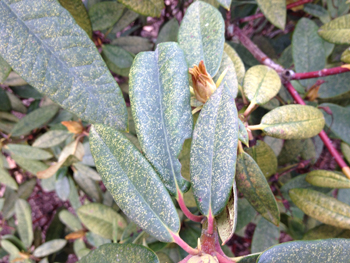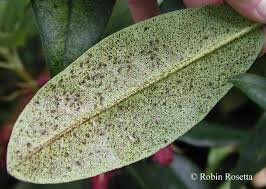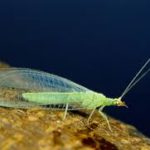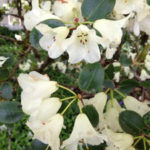 Last year I wrote a blog about a serious new insect problem for landscapes in the Pacific Northwest. It was serious because rhododendrons and azaleas make up a large percentage of the plants in most gardeners landscape. The easy way to control the insect was with a systemic pesticide that harms bees. Many people were talking about removing all their susceptible plants rather than harm bees.
Last year I wrote a blog about a serious new insect problem for landscapes in the Pacific Northwest. It was serious because rhododendrons and azaleas make up a large percentage of the plants in most gardeners landscape. The easy way to control the insect was with a systemic pesticide that harms bees. Many people were talking about removing all their susceptible plants rather than harm bees.
Here’s my latest report and what you can do to save your plants without killing bees:
Save bees and your azaleas and rhododendrons. How big a problem?
I have visited over thirty client landscapes in the Portland area since February – all the gardens but two had moderate to severe lace bug damage on rhodies and azaleas. I was already expecting the 2015 lace bug plant damage to be a huge problem for my clients. Robin Rosetta, Associate Professor, Extension Entomologist, OSU says the lace bug hatch is a full month early. This is very bad news unless you are prepared to start treating your plants now in mid-to-late April and early May.
Strong blasts of water should be applied to the back of the leaves to damage the wings of the lace bug while it is in its soft nymph stage. It can be a little difficult to hold your leaves steady to spray the back side, especially if it is a large rhododendron. Portland Nursery has something called a Bug Blaster Head for your hose. It’s easier to use and has a safer pressure for your plants’ leaves. It also has a wand attachment that would make it possible to treat a large rhododendron.
Insecticidal soaps applied to the back of the leaves will also damage the lace bug nymph. These two methods are effective only while the nymph is soft. Once it turns into an adult, soaps won’t work and water spray will not remove embedded eggs.
This may get confusing because the bad bugs that damage your plants are called lace bugs. I’m about to introduce you to a good bug that eats the bad bug. The good bugs are called green lace wings. If you don’t want to spray your plants because they are too big, there are too many plants or you want to work toward a long term solution; you need to purchase green lace wing larvae from March Biological or go to Portland Nursery to order through them. The green lace wing will eat the newly hatched lace bug and prevent the lace bug population from exploding. Getting green lace wings in a high population in your garden will help with the next one or two lace bug hatchings that we expect this year. My friend, Phil Thornburg, from Winterbloom has successfully diminished his damaging lace bug population. It took him a couple of years but he did it by applying green lace wings instead of pesticides.
Plants in full sun seem to be the most damaged from lace bug.
Basically they are stealing the green right out of the plants’ leaves and laying eggs that will hatch in another month adding insult to your already damaged plant. Remember to water your rhododendron and azaleas regularly this summer – they will need the extra support.
Question: What does lace bug on my rhododendrons have to do with bee colony collapse disorder?
Answer: Systemic drenches often contain imidacloprid. It’s popular because it’s easy, the chemical is suppose to be safer for mammals (so humans, rats, bats are pretty safe) but the spray will harm or kill bees or any insects who feed on the plant. For months afterwards bees take it back to the hive with the pollen so it’s not just harming one bee – it’s harming the colony.
The time to treat your plants without harming the bees is now!







